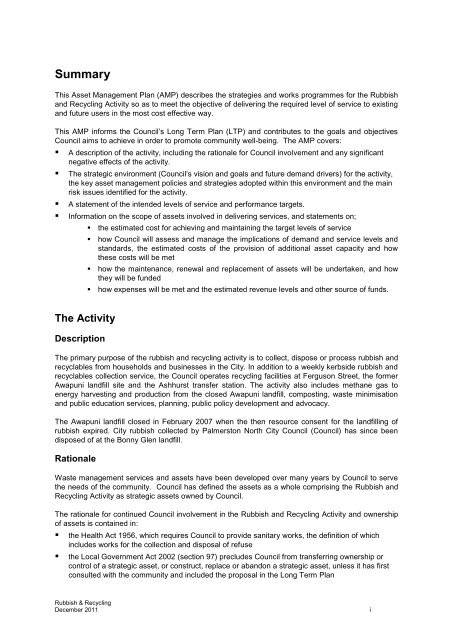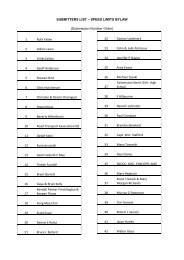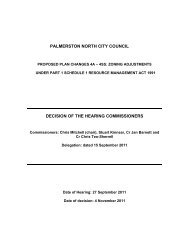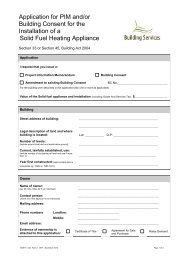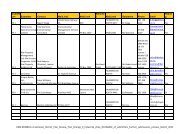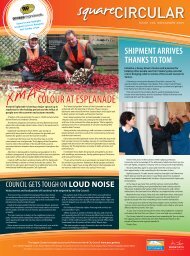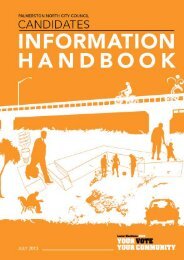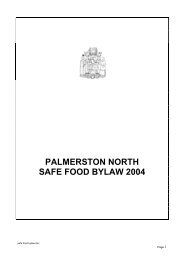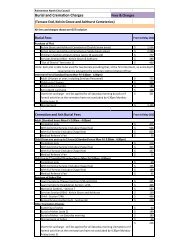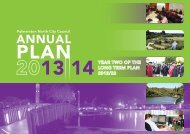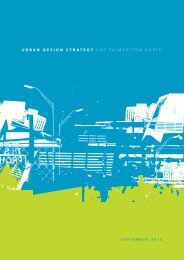Rubbish and Recycling Asset Managment Plan Summary
Rubbish and Recycling Asset Managment Plan Summary
Rubbish and Recycling Asset Managment Plan Summary
You also want an ePaper? Increase the reach of your titles
YUMPU automatically turns print PDFs into web optimized ePapers that Google loves.
<strong>Summary</strong>This <strong>Asset</strong> Management <strong>Plan</strong> (AMP) describes the strategies <strong>and</strong> works programmes for the <strong>Rubbish</strong><strong>and</strong> <strong>Recycling</strong> Activity so as to meet the objective of delivering the required level of service to existing<strong>and</strong> future users in the most cost effective way.This AMP informs the Council’s Long Term <strong>Plan</strong> (LTP) <strong>and</strong> contributes to the goals <strong>and</strong> objectivesCouncil aims to achieve in order to promote community well-being. The AMP covers:• A description of the activity, including the rationale for Council involvement <strong>and</strong> any significantnegative effects of the activity.• The strategic environment (Council’s vision <strong>and</strong> goals <strong>and</strong> future dem<strong>and</strong> drivers) for the activity,the key asset management policies <strong>and</strong> strategies adopted within this environment <strong>and</strong> the mainrisk issues identified for the activity.• A statement of the intended levels of service <strong>and</strong> performance targets.• Information on the scope of assets involved in delivering services, <strong>and</strong> statements on;• the estimated cost for achieving <strong>and</strong> maintaining the target levels of service• how Council will assess <strong>and</strong> manage the implications of dem<strong>and</strong> <strong>and</strong> service levels <strong>and</strong>st<strong>and</strong>ards, the estimated costs of the provision of additional asset capacity <strong>and</strong> howthese costs will be met• how the maintenance, renewal <strong>and</strong> replacement of assets will be undertaken, <strong>and</strong> howthey will be funded• how expenses will be met <strong>and</strong> the estimated revenue levels <strong>and</strong> other source of funds.The ActivityDescriptionThe primary purpose of the rubbish <strong>and</strong> recycling activity is to collect, dispose or process rubbish <strong>and</strong>recyclables from households <strong>and</strong> businesses in the City. In addition to a weekly kerbside rubbish <strong>and</strong>recyclables collection service, the Council operates recycling facilities at Ferguson Street, the formerAwapuni l<strong>and</strong>fill site <strong>and</strong> the Ashhurst transfer station. The activity also includes methane gas toenergy harvesting <strong>and</strong> production from the closed Awapuni l<strong>and</strong>fill, composting, waste minimisation<strong>and</strong> public education services, planning, public policy development <strong>and</strong> advocacy.The Awapuni l<strong>and</strong>fill closed in February 2007 when the then resource consent for the l<strong>and</strong>filling ofrubbish expired. City rubbish collected by Palmerston North City Council (Council) has since beendisposed of at the Bonny Glen l<strong>and</strong>fill.RationaleWaste management services <strong>and</strong> assets have been developed over many years by Council to servethe needs of the community. Council has defined the assets as a whole comprising the <strong>Rubbish</strong> <strong>and</strong><strong>Recycling</strong> Activity as strategic assets owned by Council.The rationale for continued Council involvement in the <strong>Rubbish</strong> <strong>and</strong> <strong>Recycling</strong> Activity <strong>and</strong> ownershipof assets is contained in:• the Health Act 1956, which requires Council to provide sanitary works, the definition of whichincludes works for the collection <strong>and</strong> disposal of refuse• the Local Government Act 2002 (section 97) precludes Council from transferring ownership orcontrol of a strategic asset, or construct, replace or ab<strong>and</strong>on a strategic asset, unless it has firstconsulted with the community <strong>and</strong> included the proposal in the Long Term <strong>Plan</strong><strong>Rubbish</strong> & <strong>Recycling</strong>December 2011i
• the Waste minimisation Act 2008, the purpose of which is to encourage waste minimisation <strong>and</strong>decrease waste disposalSignificant negative effects of ActivityPotential significant negative effects of <strong>Rubbish</strong> <strong>and</strong> <strong>Recycling</strong> Activity are:• Leachate from closed l<strong>and</strong>fills• Odour from the release of gas from the closed l<strong>and</strong>fill <strong>and</strong> the composting operation• Costs of rubbish & recycling services exceeding the communities ability to payCouncil is able to mitigate to varying degrees most of these potential negative effects through a mix ofl<strong>and</strong>fill design <strong>and</strong> aftercare programmes, asset development work, waste minimisation strategies,public education, the incorporation of features sympathetic to amenity, personal safety, environmentalvalues, l<strong>and</strong>fill aftercare practices in accordance with consent requirements <strong>and</strong> Ministry for theEnvironment guidelines etc.Strategic environmentVision <strong>and</strong> GoalsIn October 2011, Council endorsed the following vision <strong>and</strong> goals for the 2012-22 LTP:Vision:• Palmerston North is recognised as a vibrant, caring, innovative, <strong>and</strong> sustainable city.City Goals:• Palmerston North is a socially sustainable city where people want to live because of itssafe <strong>and</strong> easy lifestyle <strong>and</strong> its many social, cultural <strong>and</strong> recreational opportunities.• Palmerston North is a leading city in the quest to become environmentally sustainable.• Palmerston North is an economically sustainable city which attracts, fosters <strong>and</strong> retainsbusinesses <strong>and</strong> jobs to create a prosperous community.Organisational Goals:• Palmerston North City Council is financially responsible <strong>and</strong> residents are satisfied thatthey get value for money from their rates.• Palmerston North City Council underst<strong>and</strong>s the diverse views of the City’s people, makesprudent decisions, <strong>and</strong> ensures that people know what it is doing <strong>and</strong> why.This AMP has been prepared consistent with the above strategic direction. The services provided bythis activity contribute to the Council Vision <strong>and</strong> Goals as follows:. Goals Contribution• Palmerston North is a sociallysustainable city where people wantto live because of its safe <strong>and</strong> easylifestyle <strong>and</strong> its many social,cultural <strong>and</strong> recreationalopportunities.• Palmerston North is a leading cityin the quest to becomeenvironmentally sustainable.• Safe collection <strong>and</strong> disposal or processing of rubbish <strong>and</strong>recycling provides a high-level of public health protection• Potential for incorporation of recreational facilities on perimeterof closed l<strong>and</strong>fill (e.g. BMX track <strong>and</strong> biking trails.)• Conversion of the Awapuni l<strong>and</strong>fill from a rubbish disposal site toa resource recovery park• Harvesting of l<strong>and</strong>fill gas <strong>and</strong> conversion to electrical energy• Reducing waste to l<strong>and</strong> through kerbside collection, sorting <strong>and</strong><strong>Rubbish</strong> & <strong>Recycling</strong>December 2011ii
. Goals Contributionprocessing of recyclables• User pays refuse collection services• Palmerston North is aneconomically sustainable city whichattracts, fosters <strong>and</strong> retainsbusinesses <strong>and</strong> jobs to create aprosperous community.• Provision of infrastructure to support sustainable growth <strong>and</strong>creation of employment through waste minimisation activitiesSustainabilityThe key sustainability issue impacting on this activity relates to decreasing waste, particularly disposalof waste to l<strong>and</strong>fills. The <strong>Rubbish</strong> <strong>and</strong> <strong>Recycling</strong> Activity makes the following contributions to the goalof reducing waste:• Provision of a weekly, kerbside collection of recyclable materials using wheelie bins <strong>and</strong> plasticcrates to increase the amount of recycling material collected from residential <strong>and</strong> rural lifestyleareas <strong>and</strong> reduce waste to l<strong>and</strong>fill• Sorting <strong>and</strong> processing of recycling material through a materials recovery facility to reducedisposal of waste to l<strong>and</strong>fill <strong>and</strong> the amount of raw materials used in product manufacture• Diversion of green <strong>and</strong> organic waste to a composting operation at the closed l<strong>and</strong>fill• Adoption of a Waste Management <strong>and</strong> Minimisation <strong>Plan</strong> that includes programmes for thereduction, reuse, recycling <strong>and</strong> recovery of waste, last reviewed in 2009• Establishment of a resource processing <strong>and</strong> recovery hub at the closed l<strong>and</strong>fill site in conjunctionwith private sector material recovery lease arrangements• Provision of educational material to the community to encourage participation in the Council’swaste minimisation projectsThe areas of community well-being below describe how aspects of these sustainability issues aredealt with in this AMP. As further Council policy <strong>and</strong> goals are developed in this area they will beincorporated into future asset management planning. This is identified as an area of work in the assetmanagement improvement plan (refer to Section 10).SocialInvestment in rubbish <strong>and</strong> recycling assets <strong>and</strong> services will be driven by level of service changesrather than population growth.EnvironmentalCouncil has statutory obligations under the Waste Minimisation Act 2008 to promote effective <strong>and</strong>efficient waste management <strong>and</strong> minimisation within the City. The Council has embraced sustainablewaste management practices <strong>and</strong> has produced a Waste Management <strong>and</strong> Minimisation <strong>Plan</strong>(WMMP), reviewed in 2009, to give effect to its vision of effective progress towards zero waste forPalmerston North. The next review of the WMMP is due in 2012.EconomicThe cost of the rubbish <strong>and</strong> recycling activity is an impost on the residents <strong>and</strong> business in the City.The strategies <strong>and</strong> funding policies in this plan are focused on gaining efficiencies from the rubbishcollection service <strong>and</strong> funding the activities on a user pays basis.<strong>Rubbish</strong> & <strong>Recycling</strong>December 2011iii
CulturalThe discharge to the environment of l<strong>and</strong>fill leachate <strong>and</strong> odours would be offensive to thecommunity. This AM <strong>Plan</strong> contains environmental monitoring programmes, capital works <strong>and</strong> wasteminimisation strategies to minimise the quantity <strong>and</strong> impact of contaminants generated by the wastemanagement activity.Growth <strong>and</strong> dem<strong>and</strong> driversThe latest Statistics NZ population projections (2010 update) suggest the city will reach a populationof 94,000 people by 2031, an increase of 15,000 people from the population in 2006. The mediumpopulation growth projection for Palmerston North of average annual growth of 0.7% between 2006<strong>and</strong> 2031 is only slightly below the national population growth projection of 0.8% per annum.This <strong>Plan</strong> is based on providing for a population growth of 0.7% per annum over the first 10-yearsfollowed by a growth rate of 0.6% per annum over the 2 nd 10-year period. The average annual growthrate over the 2012 - 2022 year period, based on a medium growth rate planning scenario, is 0.63%.Household growth rate, under a medium growth scenario, is based on an average 1.03% per annumover the same 20-year planning period.Based on the 20 year average residential preferences from 1991 to 2010 <strong>and</strong> the Statistics NewZeal<strong>and</strong> household growth projections, the following distribution of lots is projected for the Cityassuming a medium growth scenario (excluding apartments) <strong>and</strong> that preferences remain constantover the 20 year period from 2012 to 2032.Projected Residential Dwelling Preference for 2012 – 2032 (20 years)Statistics NewZeal<strong>and</strong>Projection (2006base) 2010updateGreenfield(Lots perannum)Infill(Lots perannum)Rural/Residential(Lots per annum)Total Lotsrequired from2012 - 2032Medium(1.03%)208 109 48 7,300Other dem<strong>and</strong> drivers for waste management services in the City include:• Social <strong>and</strong> cultural trends - the need to service population growth in the city <strong>and</strong> recognise culturalsensitivities.• Environmental requirements.• Economic strength of the city.• Central Government’s <strong>and</strong> the community’s desire to reduce reliance on l<strong>and</strong>fills to managewaste.Dem<strong>and</strong> managementDem<strong>and</strong> management is incorporated into this plan as follows:• Using the Waste Management <strong>and</strong> Minimisation <strong>Plan</strong> review to develop the future direction forthis activity• Pricing of waste management services to incentivise waste minimisation <strong>and</strong> recycling <strong>and</strong>discourage waste disposal<strong>Rubbish</strong> & <strong>Recycling</strong>December 2011iv
RiskThe significant risk issues identified for the <strong>Rubbish</strong> <strong>and</strong> <strong>Recycling</strong> Activity for which mitigation worksare programmed are:• Non-compliance with resources consents for l<strong>and</strong>fill discharges to ground <strong>and</strong> air.• Failure to identify <strong>and</strong> meet the community’s requirements.• Potential risks identified in investigations to be completed relating to ground conditions <strong>and</strong>/orstructures at the Awapuni closed l<strong>and</strong>fill as a result of a major earthquakeLevels of serviceThe current refuse <strong>and</strong> recycling collection services are provided:User GroupService ProvidedResidential Users Provision of weekly rubbish <strong>and</strong> kerbside collection of recyclables.Provision of a waste transfer station at Ashhurst.Provision of a recycling drop-off centre at Ferguson Street <strong>and</strong> Awapuni.Commercial <strong>and</strong>Industrial UsersAll UsersAll UsersProvision of twice weekly rubbish <strong>and</strong> weekly recycling collection service in the CentralBusiness District.Green waste disposal <strong>and</strong> recycling facilities.Environmental education.L<strong>and</strong>fill gas harvest <strong>and</strong> conversion to energyDevelop a range of waste minimisation service options for consideration by Councilfollowing the next review of the Waste Management <strong>and</strong> Minimisation <strong>Plan</strong> in 2012.Key Performance MeasuresThe KPIs adopted for the <strong>Rubbish</strong> & <strong>Recycling</strong> activity, the current performance (where available) areshown in the table below. The Council goals that link to each performance measure are shown asfollows<strong>Rubbish</strong> & <strong>Recycling</strong>December 2011v
:<strong>Rubbish</strong> & <strong>Recycling</strong>December 2011vi
LoSCategoryUser Group Level of Service(Domestic Users)CustomerMeasurePerformanceCurrentperformancePerformance targets(Goal)(Years 1-20)2012/13 2013/14 214/15 2015/16 –2021-22QualityHealth(CG – S)&Residential <strong>and</strong>commercial propertyowners <strong>and</strong>occupiersCouncil provides rubbishcollection service tomaintain hygienest<strong>and</strong>ards in the CityResidents are satisfied withthe quality of Council’srubbish collection services.92% At least85%At least85%(surveycompletedevery 2years)Reliability(CG – S)Residential <strong>and</strong>commercial propertyowners <strong>and</strong>occupiersCouncil provides areliable rubbish <strong>and</strong>recycling service<strong>Rubbish</strong> <strong>and</strong> recycling arecollected on the stated days<strong>and</strong> at the stated times(New KPI) 100% 100% 100% 100%Residential <strong>and</strong>commercial propertyowners <strong>and</strong>occupiersCouncil responds torequests for service in aprompt <strong>and</strong> efficient wayCalls about missedcollections are responded toin 2-hours (initial responseonly)(New KPI) 100% 100% 100% 100%Accessibility(CG – S)Residential propertyowners <strong>and</strong>occupiersCouncil provides weeklyrubbish <strong>and</strong> recyclingkerbside collectionservice to residentialareas of the CityResidents are satisfied withthe quality of the rubbish <strong>and</strong>recycling service92% At least85%At least85%(surveycompletedevery 2-years)Commercialproperty owners<strong>and</strong> occupiersCouncil provides twiceweeklyrubbish <strong>and</strong>recycling kerbsidecollection service to theCBD area of the City(Being developed)All residentsCouncil provides greenwaste disposal facilitiesfor the CityGreen waste facility isavailable <strong>and</strong> open for thestated hours100% 100% 100% 100% 100%All residentsCouncil provides rubbish<strong>and</strong> recycling collectionpoints for customersCollections points areavailable <strong>and</strong> open for thestated hours100% 100% 100% 100% 100%<strong>Rubbish</strong> & <strong>Recycling</strong>December 2011vii
LoSCategoryUser Group Level of Service(Domestic Users)CustomerMeasurePerformanceCurrentperformancePerformance targets(Goal)(Years 1-20)2012/13 2013/14 214/15 2015/16 –2021-22outside of the kerbsidecollection serviceSustainability(CG – En)(OG – F)All residents Council disposes ofwaste in an efficient <strong>and</strong>sustainable wayVolume of waste to l<strong>and</strong>fill isreduced.770 kg per headin 2007- 500kg perhead ofCitypopulation500kg perhead ofCitypopulation500kg perhead ofCitypopulationCompliance with resourceconsent monitoring conditionsthat relate to environmentaleffects.100% 100% 100% 100% 100%Affordability(CG – Ec)(OG – F)All usersCouncils maintains <strong>and</strong>develops rubbish <strong>and</strong>recycling services tomeet current <strong>and</strong> futureneeds in a cost effectivewayA 20-year asset managementplan is in place for thestormwater activity<strong>Plan</strong> in place. 3-yearly reviewcompleted<strong>Plan</strong> inplace<strong>Plan</strong> inplace<strong>Plan</strong>reviewed<strong>Plan</strong>reviewed3-yearlyAll usersThe Council manages its<strong>Rubbish</strong> <strong>and</strong> <strong>Recycling</strong>activity in a financiallyresponsible wayWork programmes areachieved within budget+11.1%(Operatingexpense result,2010/11)Describework done<strong>and</strong> %budgetspentDescribework done<strong>and</strong> %budgetspentDescribework done<strong>and</strong> %budgetspentDescribework done<strong>and</strong> %budgetspentNote: Levels of service primarily apply to customers in the urban area. These levels of service do not apply to rural residents or customers except for drop –off points <strong>and</strong> green waste disposalfacilities.Satisfied percentages include “very satisfied <strong>and</strong> “fairly satisfied “<strong>and</strong> exclude those who don’t know or who are “neither satisfied nor dissatisfied”.Measures shown in italics are proposed to be included in the 2012-22 LTP.<strong>Rubbish</strong> & <strong>Recycling</strong>December 2011viii
The anticipated changes to current services over the next 20 years are:Proposed Changes Community Impact Cost Impact<strong>Rubbish</strong> <strong>and</strong> recycling service:- extended rubbish <strong>and</strong> recyclingcollection system. Includes rurallifestyle properties <strong>and</strong> CBDDevelopment of infrastructure at siteto support resource recoveryoperations, commercial leases <strong>and</strong>composting.Exp<strong>and</strong>ed refuse <strong>and</strong> recyclingcollection services improvecommunity access to kerbside refuse<strong>and</strong> recycling collection servicesImproved facilities at Awapuniimprove functional integration <strong>and</strong>commercial investment at site, witheconomic spin-offs for community.Additional costs of exp<strong>and</strong>edcollection area funded from usercharges <strong>and</strong> targeted rates.Additional costs of exp<strong>and</strong>edinfrastructure at Awapuni funded fromuser charges, commercial leases <strong>and</strong>targeted rates.<strong>Asset</strong>sScope <strong>and</strong> value of assetsThe broad asset groups <strong>and</strong> their value of the total are shown in the following graph:Awapuni & Awapuni<strong>Recycling</strong> Centre$9.035MAshhurst TransferStation $0.185MAwapuni L<strong>and</strong>fill$9.391M<strong>Recycling</strong> Bins &Crates $2.474M<strong>Asset</strong> condition <strong>and</strong> performanceAwapuni l<strong>and</strong>fill• Compliance with resource consents – the l<strong>and</strong>fill is operated in compliance with resourceconsents for the discharge of leachate, l<strong>and</strong>fill gas, dust, odour, stormwater, l<strong>and</strong>fill gas <strong>and</strong>composting activities• Appearance – the l<strong>and</strong>fill appearance has historically been rated as satisfactory in residentsurveys, however the on-going programme of capping, top-soiling <strong>and</strong> planting is improving thevisual aesthetics needs more attention• Capacity – site layout needs review to improve functionality of the overall site, streamline workprocesses <strong>and</strong> avoid overlap of conflicting activities<strong>Rubbish</strong> & <strong>Recycling</strong>December 2011ix
Transfer stations• Condition – all assets are less than 13 years old <strong>and</strong> in good condition• Capacity – the Ashhurst transfer station has sufficient capacity to meet current <strong>and</strong> projectedwaste volumes.<strong>Recycling</strong> bins<strong>Recycling</strong> wheelie bins <strong>and</strong> crates for kerbside recycling collection were introduced in 2010 <strong>and</strong> are ingood condition.Materials Recovery Facility (MRF)Less than 12 months old <strong>and</strong> in good condition. Improvements to the sort line in late 2011 areintended to improve the performance of the facility.Operation <strong>and</strong> maintenance of assetsThe operations <strong>and</strong> maintenance strategy is intended to retain the current levels of service, mitigaterisk <strong>and</strong> minimise costs by implementing a balanced programme of planned, preventative <strong>and</strong>reactive works. The risk analysis has not highlighted any unacceptable risks associated withoperational <strong>and</strong> maintenance of the activity.Renewal of assetsThe asset renewal programme is intended to maintain overall asset condition <strong>and</strong> hence the servicepotential.<strong>Asset</strong> renewal needs are identified through analysis of condition assessments <strong>and</strong> failure history.Treatment selection <strong>and</strong> work prioritisation are determined from an economic analysis of optionsconsidering all asset life cycle costs.Major renewal works planned over the 20 year planning period include:• Roading, drainage <strong>and</strong> activity infrastructure renewals at the Awapuni site - $1.4M• Improvements to staff facilities in 2012/13 - $50,000• <strong>Recycling</strong> wheelie bin <strong>and</strong> crate replacements - $4.05M• Materials recovery facility renewals - $2.04MDevelopment of assets<strong>Asset</strong> development needs to meet dem<strong>and</strong> forecasts <strong>and</strong> deliver the agreed level of service which areidentified from an assessment of risks, performance monitoring <strong>and</strong> dem<strong>and</strong> analysis. All feasibleoptions, including non-asset dem<strong>and</strong> management options, are considered. Project selection <strong>and</strong>prioritisation is determined from an economic analysis of options considering all asset life cycle costs.Capital development projects undertaken to meet level of service needs <strong>and</strong> growth are funded fromborrowing <strong>and</strong> development contributions respectively.The Council funded capital development projects programmed over the next 20 years, all relating tolevel of service improvements, are shown in the following table:<strong>Rubbish</strong> & <strong>Recycling</strong>December 2011x
20 Year Capital Development ProjectsProject Growth % LOS %TotalBudgetTiming1. Awapuni closed l<strong>and</strong>fill site – cover <strong>and</strong>l<strong>and</strong>scaping2. Awapuni site - infrastructure forcommercial, educational & recreationalactivities3. Awapuni commercial lease sitedevelopment4. Awapuni site – develop commercialgrade composting infrastructure5. Additional wheelie bins for new growthareas100% $681,000 Years 1-20100% $1,200,000 Years 1-5100% $142,665 Years 2,4 & 6100% $225,000 Years 4 & 5100% $400,000 Years 1-206. Upgrade materials recovery facility 100% $1,200,000 Years 5,10,15 &207. Community waste minimisation facility 100% $750,000 Years 1 <strong>and</strong> 2TOTAL $4,598,665 Years 1 - 20Key AM plan assumptionsThe following general assumptions have been made in preparing the expenditure forecasts:• <strong>Asset</strong>s to remain in Council ownership• External funding is based on current Government policy & won’t change over the term of this AMP• Population growth projections are based on a 0.63% median population growth rate over the full20 year planning period, comprising 0.7% for the first 10 years followed by 0.6% for the secondten years• Residential expansion is based on the proposed City West <strong>and</strong> Whakarongo areas, with the CityWest development commencing over Years 1-5 of this <strong>Plan</strong> <strong>and</strong> Whakarongo commencing inYears 6-10• Residential growth planned for Ashhurst will have a minor impact on the <strong>Rubbish</strong> <strong>and</strong> <strong>Recycling</strong>Activity over the term of the <strong>Plan</strong>.• Provision for industrial growth is based on extension of the NE Industrial Zone, assumingdevelopment of the block north of the existing site (cross boundary)• Remaining asset lives are based on latest condition assessments• Current statutory <strong>and</strong> regulatory requirements will not change over the term of this AMP• The Horizons Regional Council One <strong>Plan</strong> will have minimal effect on levels of service in the shortterm• Programmes are based on maintaining current levels of service provided by the activity <strong>and</strong>preserving current service potential of assets.• Climate change will have minimal effect on the activity over the period of the planRefuse bag collection service self-funding from 1 July 2012<strong>Rubbish</strong> & <strong>Recycling</strong>December 2011xi
Financial forecastThe figures below summarise the 20-year <strong>Rubbish</strong> <strong>and</strong> <strong>Recycling</strong> Activity financial forecasts for O &M, capital renewals <strong>and</strong> capital new for the. All expenditure is stated in 2012/13 dollar values with noallowance made for cost indice fluctuations over the 20-year planning period.Operations <strong>and</strong> maintenance$6,000,000$5,000,000$4,000,000$3,000,000$2,000,000$1,000,000$0<strong>Rubbish</strong> & <strong>Recycling</strong> Operations &Maintenance BudgetAwapuni Operations Total<strong>Recycling</strong> Collection & Processing TotalWaste Minimisation TotalR&R Operational <strong>Plan</strong>ning & Policy Total<strong>Rubbish</strong> Collection & Disposal TotalCapital - Renewals$1,000,000$800,000$600,000$400,000$200,000$0<strong>Rubbish</strong> & <strong>Recycling</strong> Capital RenewalAwapuni L<strong>and</strong>fill - Gas Collection RenewalsAwapuni L<strong>and</strong>fill - Improved Staff Facilities<strong>Recycling</strong> - Materials Recovery Facility Renewals<strong>Recycling</strong> - Wheelie Bin <strong>and</strong> Crate ReplacementsAwapuni L<strong>and</strong>fill - Roading, Drainage & Infrastructure Replacements<strong>Rubbish</strong> & <strong>Recycling</strong>December 2011xii
Capital – New$1,200,000$1,000,000$800,000$600,000$400,000$200,000$0<strong>Rubbish</strong> & <strong>Recycling</strong> Capital NewAwapuni L<strong>and</strong>fill - Gas Pipeline Link <strong>and</strong> Decommissioning<strong>Recycling</strong> - Materials Recovery Facility Upgrades<strong>Recycling</strong> - Wheelie Bins & Crates to New Growth AWaste MinimisationAwapuni L<strong>and</strong>fillThe significant trends in the financial forecasts are:Operation <strong>and</strong> Maintenance• Expenditure remains relatively constant after 2016/17 when the supply contract for thecogeneration unit at the l<strong>and</strong>fill gasfield expires.Renewals• Provision is made for renewal <strong>and</strong> rehabilitation of some assets as they come to the end of theirfunctional life. It includes the st<strong>and</strong>ard distribution replacement profile assumed for the recyclingwheelie bins <strong>and</strong> crates.Capital Development• A total of $4.9M is budgeted over the 20 year planning period for final l<strong>and</strong>fill closure <strong>and</strong>development works, extensions to the recycling collection services, organic waste utilisation <strong>and</strong>for implementing the waste minimisation strategy.Improvements to asset management planningImprovement activities planned for the next 3 years include the following:• Review the Council’s Waste Management <strong>and</strong> Minimisation <strong>Plan</strong>• Capital renewal <strong>and</strong> development project planning – develop strategies <strong>and</strong> processes to takeinto account a sustainable development approach.• Review dem<strong>and</strong> projections on an on-going basis consistent with Council’s Residential GrowthStrategy. Further develop predictive modeling (e.g. dTIMMs <strong>and</strong> Hansen AMS), risk basedapproaches to help prioritise programmes <strong>and</strong> better manage risks <strong>and</strong> costs in achieving thedesired outcomes• Update City-wide asset development plans <strong>and</strong> incorporate structure plans for new growth areas<strong>Rubbish</strong> & <strong>Recycling</strong>December 2011xiii
• Periodically review risk assessment to enhance optimised decision-making capability.• Investigate <strong>and</strong> develop appropriate mitigation strategies for Council’s assets in the event of amajor earthquake.• Operations <strong>and</strong> maintenance – ongoing review of contracting <strong>and</strong> internal service agreementstrategies to achieve the best balance of risk transfer, cost <strong>and</strong> performance based focus.• <strong>Asset</strong> information – on-going updating of asset condition data <strong>and</strong> rationalisation <strong>and</strong>development of systems to meet all asset management needs <strong>and</strong> integration of assetinformation activities within Council.• Level of service – undertake stakeholder consultation on new major issues to updateunderst<strong>and</strong>ing of community expectations <strong>and</strong> preferences. Review levels of service with Councilevery three years• AM resource planning to ensure the recruitment, retention <strong>and</strong> development of sufficient <strong>and</strong>suitably qualified staff.• Review asset management strategy to take account changes in Council direction <strong>and</strong>Government policy.<strong>Rubbish</strong> & <strong>Recycling</strong>December 2011xiv


